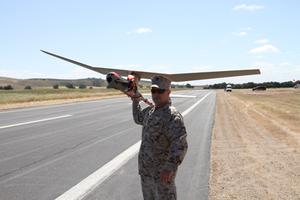UAVsU.S. military seeking non-lethal UAVs
The U.S. Army is seeking non-lethal warheads to be deployed on tiny UAVs; the U.S. Army describes the possible uses of the non-lethal UAV: “Potential commercial applications might include, but are not limited to: crowd control for local law enforcement; border protection for Homeland Security; or temporary incapacitation of non violent criminals for local SWAT teams and/or law enforcement”

Hand launching a FQM-f51 pointer armed with non-lethal payload during testing // Source: nps.edu
The age of the modern UAV began in 1982, with Israel being the pioneer in this new form of warfare. The Israel Air Force (IAF), smarting from the heavy losses it had suffered from Soviet-built surface-to-air missiles (SAM) deployed by Egypt and Syria in the 1973 war, decided to turn to UAVs for use in surveillance, operations, and as decoys. The proof-of-concept came during the first Lebanon war, in 1982, when a combination of Israeli UAVs and fighter planes completely neutralized the Syrian air force and air defenses. The IAF shot down more than eighty Syrian planes and also destroyed thirty Syrian anti-aircraft missile batteries, with no air to air losses of its own.
The United States began to buy UAVs from Israel in the early 1990s, but they were slow to integrate into the U.S. military. The pace of integration picked up as the united States, even before the 9/11 attacks, began to pay more attention to the problem of terrorism.
The U.S military initially used UAVs for surveillance and information gathering, and since the middle of the last decade, UAVs have been used more and more as hunter-killers, targeting terror-related targets in Iraq, Afghanistan, Pakistan, Yemen, and Somalia.
The U.S. military is now looking for UAVs for yet another type of missions. This is the way the U.S. Army, in its RFP, describes the possible uses of the non-lethal UAV: “Potential commercial applications might include, but are not limited to: crowd control for local law enforcement; border protection for Homeland Security; or temporary incapacitation of non violent criminals for local SWAT teams and/or law enforcement.”
sUAS Newsnotes that the purpose of this new approach is to develop non-lethal warhead which will be deployed on miniature precision munitions such as Lethal Miniature Aerial Munition System (LMAMS). LMAMS is a small, soldier-carried, soldier-launched loitering precision munitions system which is organic at the small unit level. LMAMS aim to offer soldiers a portable, non-line-of-sight precision strike capability against stationary or moving individuals. With LMAMS, soldiers will have a system capable of achieving high precision effect from covert positions, with a low risk of collateral damage.
Geek notes that LMAMS, when launched, will acquire its target in less than twenty seconds. LMAMS vehicles fly 100 meters above the target, and can circle for up to thirty minutes if there is not a clear shot.
The Army has also specified what it is looking for in the non-lethal warhead with which the LAMAS will be equipped: the warhead must be no bigger than 1.2 x 1.2 x 2.1 inches, 96 grams or lighter, impact at no more than 100mph, and cost less than $500 per unit.
